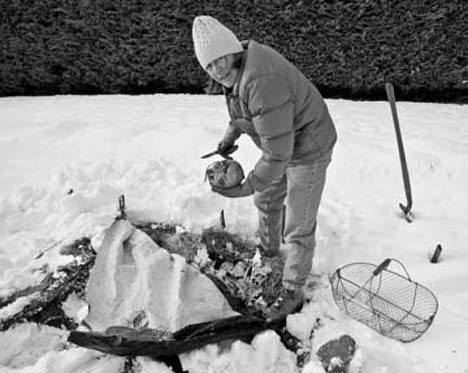I’ve been gardening in the Pacific Northwest for 30 years and I’m still thrilled that I can grow a winter vegetable garden here.
The pleasure is partly that you can do it—plant seeds in mid-summer and harvest fresh vegetables in mid-winter—and partly that these winter vegetables taste so good, sweeter and richer with each frost.
But what is a winter vegetable anyway? Potatoes, squashes, onions, dried beans are vegetables planted in the spring, harvested in the fall, and stored and eaten the winter, but vegetables that thrive in the garden during our marine winters are what amaze me and earn the name winter vegetable.
Hardy greens like kale and chard; salad greens like arugula, mustard, mache, escarole, endive and radicchio; cole crops like Brussels sprouts and cabbage; leeks and finally the roots, my particular favorites: carrots and beets, yes, but also parsnips, celery root, turnip, and, most surprisingly delicious, rutabaga.
But while these are winter vegetables, they are planted in summer and there is the challenge. A few, like celery root, leeks, parsnips and Brussels sprouts seem to mature best planted in late May and early June when many of us are still in planting mode, but the rest thrive from mid to late July planting. It does take some planning to find garden space and planting time in mid-July, but it’s worth it to have fresh vegetables all winter long.
If you can make the time and space for winter vegetables this year, try starting with kale and a few roots like carrots, turnips and rutabaga. Territorial Seed Company’s winter catalog or websitewww.territorialseed.com/ are good places to begin exploring varieties. Winterbor and Winter Red kale have never failed me. While there are lots of winter carrot choices, I keep returning to Mokum for its flavor. And Gilfeather turnip, available from Fedco www.fedcoseeds.com/index.htm, and Marion rutabaga from Territorial are the two big winter roots I most look forward to.
Plant the seeds in deeply worked soil and keep the soil moist until they germinate. Cover the rows with Reemay to provide a little shade and a barrier against birds and bugs. Thin kale plants to 12 inches apart and turnip and rutabaga to eight inches when they’re two or three inches tall and keep thinning carrots as they grow. Mulch at this point to help conserve moisture and to keep the soil from freezing when winter arrives.
As the day length shortens and temperatures cool, these vegetables will flourish, providing pockets of green amid the yellowing, drying summer vegetables. By late October they will be full size and will hold in the ground, growing slowly if at all, until lengthening daylight in spring restarts their growth.
Wait for frost and then begin to harvest. If temperatures below twenty degrees are forecast, extra mulch around the plants and plastic or lumber wrap over them will insure they survive until temperatures moderate and you can remove this temporary blanket.When seed catalogs say: “better after several frosts” they mean it. Winter vegetables become sweeter with cold. What happens is that cold causes a vegetable like kale to produce sugars and roots like turnip and rutabaga to convert their starch to sugars.
Roasting winter roots is a good way to take advantage of these sugars. Try slicing peeled rutabagas and turnips into thick French fry strips, tossing them lightly in olive oil and roasting them at 400 degrees for 30-45 minutes. Do the same with carrots. The sugars caramelize and the roots brown and soften into an earthy, rich winter treat. Pull kale from the stems and braise it in a little water until it’s tender then sauté in olive oil with garlic and red pepper flakes, or enjoy it plain and sweet.
It’s really the tastes of winter vegetables that inspire me to start a winter garden in the middle of summer. Try it this year and see if you agree.
For information about growing other winter vegetables, check out Binda Colebrook’s Winter gardening in the maritime Northwest: Cool Season Crops for the Year-round Gardener, available at Lopez Library or order Linda Gilkeson’s Year-Around Harvest: Winter Gardening on the Coast from www.saltspringseeds.com/catalog/books.cfm. And if you’ve been part of the Grow a Row project this summer, add a row of winter vegetables to share.



